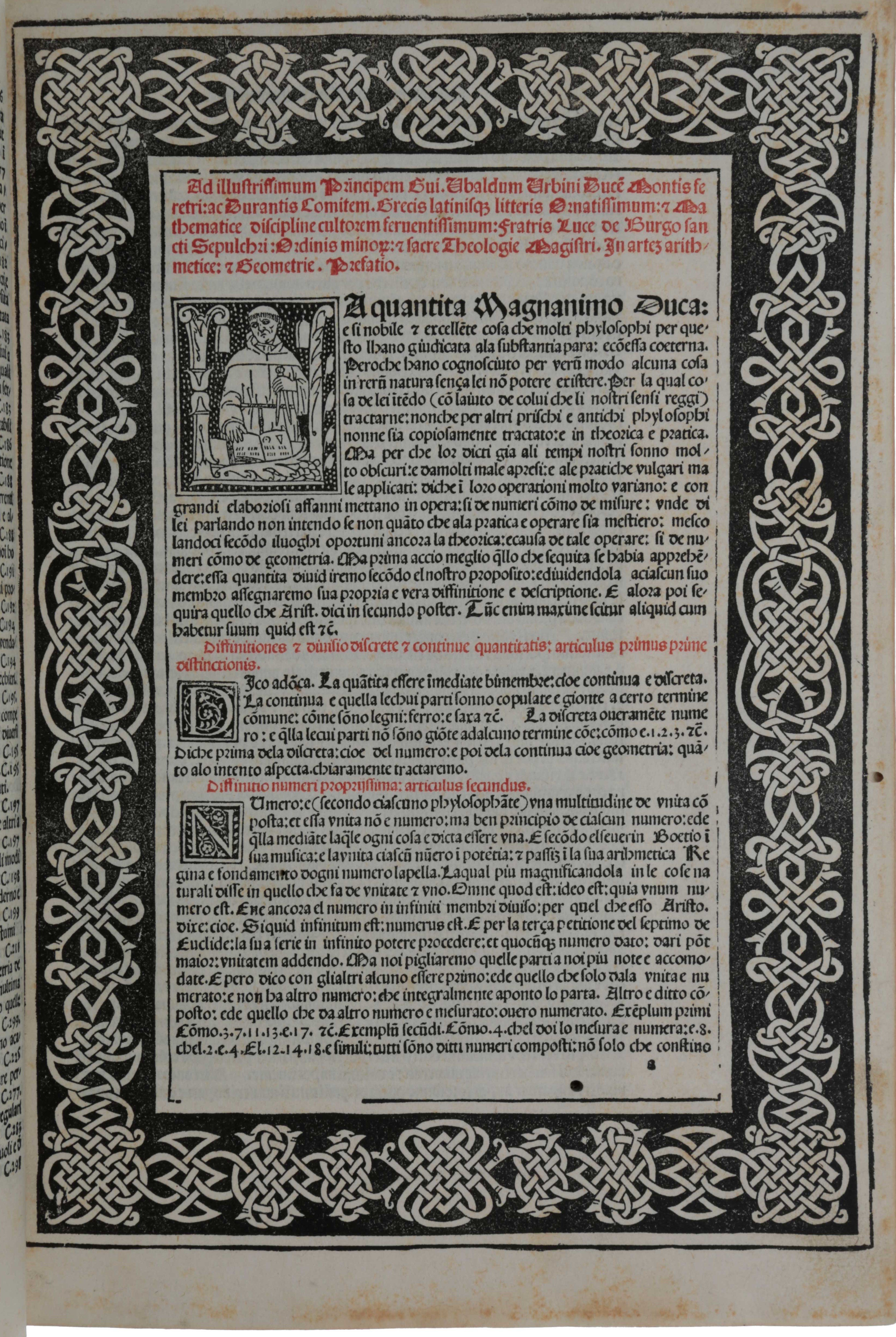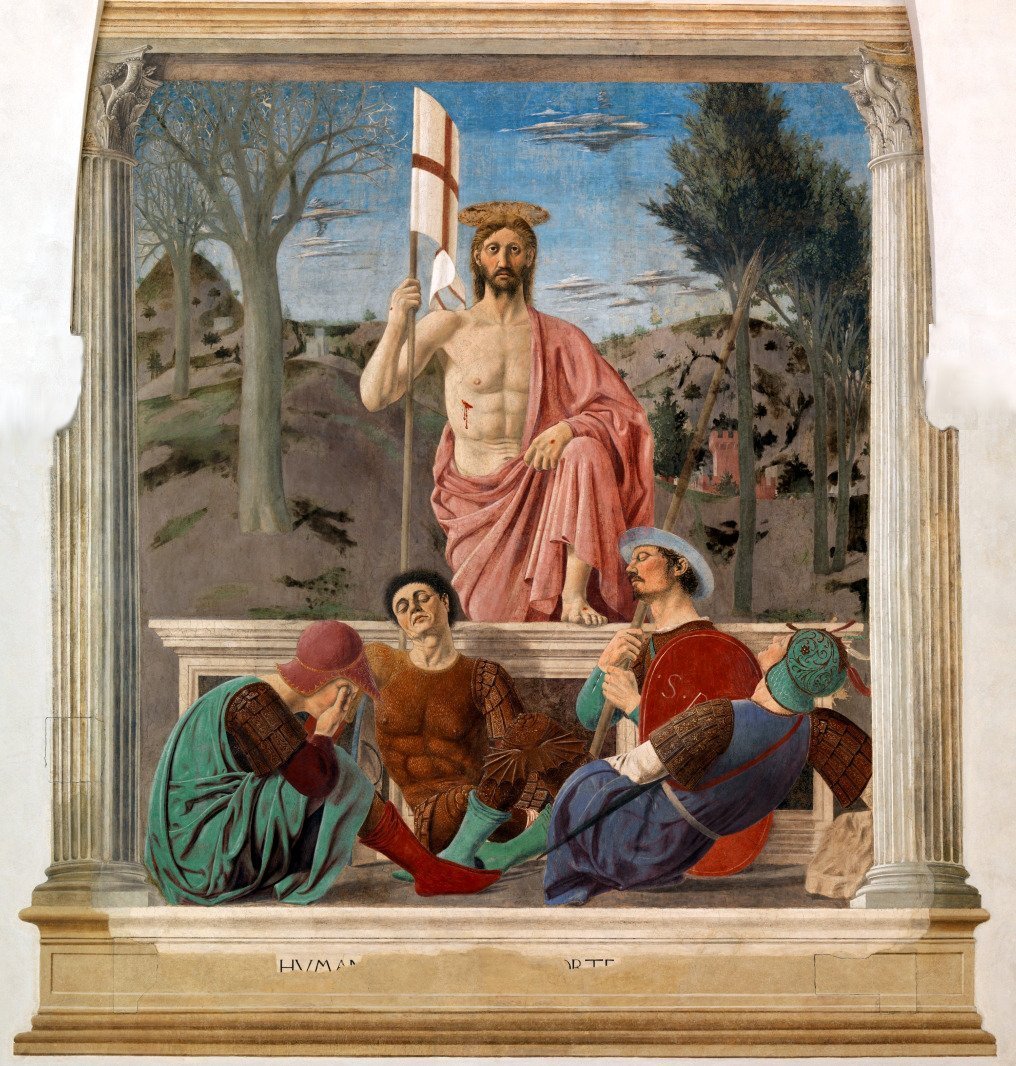Luca Pacioli and the mathematical Renaissance
The Renaissance mathematician Luca Pacioli is the crystalline symbol of his shattered dream: an orderly word expressed in numbers
The story of the mathematician Luca Pacioli (circa 1446-48 – 1517) doesn’t lack controversy. Accused of plagiarism a few times, he was allegedly dishonest. For example, a few pages from Piero della Francesca’s Libellus de quinque corporibus regularibus would be one of his most notable “dexterous thefts.”
There is more than controversy to Pacioli though. His most recent biographers agree that he was a man of boundless culture, also beyond the field of mathematics for which he is most known. Sources confirm he was an inspiring figure for the most important philosophers, scholars and artists of his time, such as Marsilio Ficino, Leon Battista Alberti, Leonardo da Vinci, as well as a great promoter of science and its most esoteric deviations. Pacioli’s work brings together all the Western mathematical knowledge of the Renaissance.
Unsurprisingly, his book Summa de Arithmetica is currently on sale for the record price of $ 1,350,000 at Sophia Rare Books, a Danish antique book dealer specializing in mathematics and physics. Five centuries ago, even Leonardo da Vinci had to pay an immense sum (16 denari) to acquire a copy of Summa—money well spent considering how much this book inspired the popular Florentine artist.

An economist as well as mathematician, Luca Pacioli was the son of a modest farmer—“an ignoble family of little splendor” as a commentator said at the time. He became a friar early on in his life, like all his brothers. His small hometown of Sansepolcro is not without significance, given that Piero della Francesca, the Renaissance artist most keen on questions of mathematics worked there extensively.
About thirty years older than Pacioli, Piero had left traces of his geometric obsession in the works carried out in the village: Saint Julian, Saint Louis of Toulouse, and the famous Resurrection. Pacioli’s inclination for geometry and mathematics supposedly began when he discovered these artworks. “A very young Luca begins to observe the world created by God as a great mathematical order, a regular succession of geometric forms in which a supreme intelligence manifests.” Stefano Zuffi noted.

Science and religion were the cornerstones of Pacioli’s life, even if the former had the upper hand over the latter. Orphaned at the age of 10, the young boy probably saw the Franciscan order and pious life as an opportunity to deepen his studies on that “universe created according to number, weight and measure,” a path that would lead him to elaborate unprecedented scientific speculations.
In 15h and 16th century Italy, mathematics was not a single discipline. It had two faces: one for the merchants and one for the scholars. The first concerned the world of technical and practical knowledge for the sake of profession; the second, developed in universities, was linked to theory and abstraction. With Pacioli, on the other hand, the practical and the speculative came together in one person.
Aged 18, Pacioli moved to Venice to serve the wealthy businessman Antonio Rompiasi, acting as his secretary, putting the science of numbers at the service of commerce. At the same time, the mathematician substantially furthered academic knowledge during his studies at the prestigious Rialto School, where he also came into contact with the Ancient Greek and Roman worlds.
For Pacioli, the world of numbers would more and more synthesize theory and practice, both of which he felt he had to circulate. It is no coincidence that he mostly wrote in vernacular instead of Latin—a language increasingly reserved to the academic niche—so his work could be read by many more.
With this holistic approach to his discipline, Pacioli also took an interest in art and the great Renaissance personalities such as Filippo Brunelleschi, Leon Battista Alberti and, later, Albrecht Durer. He thought that art was the ground where practical and theoretical expertise could merge. Recalls Luigi Grasselli: “We should credit artists for the 15th century fusion of the two seemingly antithetical fields of science and technology, a fusion that will lay the foundations for the rapid development of modernity.”
In Pacioli’s formative journey, the translations of the treatises of Euclid, Archimedes, Ptolemy, Vitruvius, and al-Khwarizmi (the Arab mathematician whose name is the origin of the word “algorithm”) would be fundamental. But equally crucial was the friendship with the much older Leon Battista Alberti, who hosted a twenty-year-old Pacioli in his own home in Rome for several months. The experienced intellectual would transmit his vision of the world to the young apprentice, a vision that Pacioli later expressed clearly in his books Divina Proportione and Treatise on Architecture.
Pacioli frequently moved from city to city. After Venice and Rome, he lived in Urbino, Perugia, Zara and Naples, where he was in contact with the local scene of humanists and he would begin to draft Summa de Arithmetica. However, for this work to see the light, more journeys and more fruitful intellectual relationships were still needed, especially those in the Roman circle of Giuliano della Rovere, the future pope Julius II and one of the most important patrons of the arts of all time.

After his second Roman experience, Pacioli finally completed his most famous and richest treatise in Venice: that Summa de Arithmetica that is now considered one of the most important books on mathematics of the European Renaissance. First printed in 1494 by publisher Paganino Paganini, Summa is divided in two parts. The first is largely based on the Liber Abaci (1202) by the famous mathematician Fibonacci, mostly remembered for having introduced Arabic numbers to the West. The second part, on geometry, is still based on Fibonacci but also includes a section on stereometric geometry and regular solids from Piero della Francesca.
In accordance with Pacioli’s practical approach, the first part of Summa contains sections that illustrate the applications of arithmetic and algebra to business-related problems. For example, it is the first printed text to expose the method of double entry accounting, a method that earned Pacioli the title of “father of accounting.” Also famous in Summa is the full-page woodcut of the finger count, from which our modern “digital calculation” takes its name.
Pacioli’s book has also been called the most influential text in the history of capitalism. Writes Jeremy Cripps, a scholar and translator of Pacioli: “Five hundred years ago, in November 1494, one of the world’s first printed texts included a section on accounting, providing guidelines to record economic activity and now applied by all major businesses.”
Summa is also a synthesis of Pacioli’s geometric knowledge, starting from his obsession with polyhedra, that is, regular geometric solids—or Platonic, as they were first described in Plato’s Timaeus. This interest can be traced back to the mathematician’s young relationship with Piero della Francesca, an inspirational figure for him and largely present in the earlier Divina Proportione.
Pacioli’s treatise on architecture can be considered the quintessential textbook on geometric perspective. For it, the mathematician drew Platonic solids to be exhibited to his influential patrons and friends such as Ludovico Sforza, Galeazzo Sanseverino, Pier Soderini, and the Duke of Urbino Guidobaldo da Montefeltro, to whom Summa is dedicated. According to many scholars, Guidobaldo is the character depicted alongside Pacioli in his well-known portrait attributed to the painter Jacopo de ‘Barbari, dated 1495 and now preserved in the Capodimonte museum in Naples.
[To know more about a symbolic fly depicted in this picture, here is our article on Renaissance and Baroque painted flies. Ed.]
In the painting, Pacioli’s finger points to a book by Euclid, while his Summa rests on the table to his left, surmounted by a regular wooden dodecahedron. Another large polyhedron, with twenty-six faces (18 squares and 8 equilateral triangles), hangs from a thread. It is in this suspended solid that most of the enigmas of this painting are found. For example, the polyhedron is half filled with water and its faces reflect the ducal palace of Urbino three times.

Even beyond the suggestions of numerical symbolism attributed to the polyhedron, the solid hanging from the thread refers directly to the tables with the solids drawn by Leonardo for another treatise by Pacioli: De Divina Proportione from 1497. Among the mathematician’s many travels and relationships with artists, the one with Leonardo in Milan, which lasted at least three years starting from 1946 is especially important.
Leonardo had already heard of Pacioli before the mathematician even moved to Milan. At the court of Ludovico il Moro, the artist first obtained Pacioli’s Summa and finally got to meet and befriended him, which marked the beginning of an exceptionally fruitful collaboration. From Pacioli, the artist learned Euclid’s theories, which allowed him to expand his research not only into geometry but also physics and anatomy.
A few works by Pacioli now live only in the chronicles, and some are less known such as a collection of mathematical puzzles written between 1496 and 1508, as well as a new translation of Euclid from 1509. However, his most influential work remains Summa, whose cultural importance and rarity of first edition copies prompts impressive monetary quotations such as that of Sophia Rare Books. Only three other copies have been seen at auction in the last 50 years, of which only one was in its original binding (sold at Christie’s New York in 2019 for $ 1,215,000).
“Just as his theories begin to spread”, writes Stefano Zuffi, “Pacioli’s ideal world shatters in front of reality. In 1492 history takes a new path: Piero della Francesca dies in Sansepolcro; Columbus sets foot on a land beyond any measured horizon; Savonarola sets Florence on fire with apocalyptic sermons; the splendor of the Sforza court ends in ruins; foreign armies enter Italy; Venice is at war. The exactness of geometry is dispersed among conflicts, the ideal city is shocked by roaring guns.”

The orderly world so well expressed by Pacioli was over. Today, the mathematician remains but a crystalline symbol of a dream, one of measuring the world through rules and representing it with geometry. We owe him an idea of tracing the entire cosmos back to numbers and fundamental shapes. This is how Pacioli marked our time.
What survives are the beautiful exchanges with the contemporary artists he befriended. We cannot think of Luca Pacioli’s mathematics without the art of Piero della Francesca and Leonardo, without the architecture of Alberti, without the utopia of an ideal city envisioned by many painters. In the same way, it is unthinkable to penetrate Renaissance art without keeping in mind the monumental work of this brilliant friar, a mathematician who lived his entire existence in an incurable contradiction: to investigate the concrete science of the earth as an expression of an incommensurable divine intelligence.
Bibliography
- E. Giusti, C. Maccagni (a cura di), “Luca Pacioli e la matematica del Rinascimento”, Giunti, Firenze, 1994
- S. Zuffi (a cura di), “Luca Pacioli tra Piero della Francesca e Leonardo”, Marsilio, Venezia, 2017
- F. Camerota, F.P. Di Teodoro, L. Grasselli (a cura di), “Piero della Francesca, il disegno tra arte e scienza”, Skira, Milano, 2015
- J. Tomlow, “Un’interpretazione fisica dell’oggetto in vetro nel ritratto di L. Paciolis di Jacopo de ’Barbari” (1495), in Architectura, XXX (2000)
- M. Seracini, “Riflettografie del Ritratto di Luca Pacioli con allievo”, in “Piero e Urbino, Piero e le corti rinascimentali”, catalogo della mostra a cura di P. Dal Progetto, Venezia, 1992
April 5, 2022
